Ultrahigh Responsivity In2O3 UVA Photodetector through Modulation of Trimethylindium Flow Rate
Abstract
:1. Introduction
2. Materials and Methods
3. Results
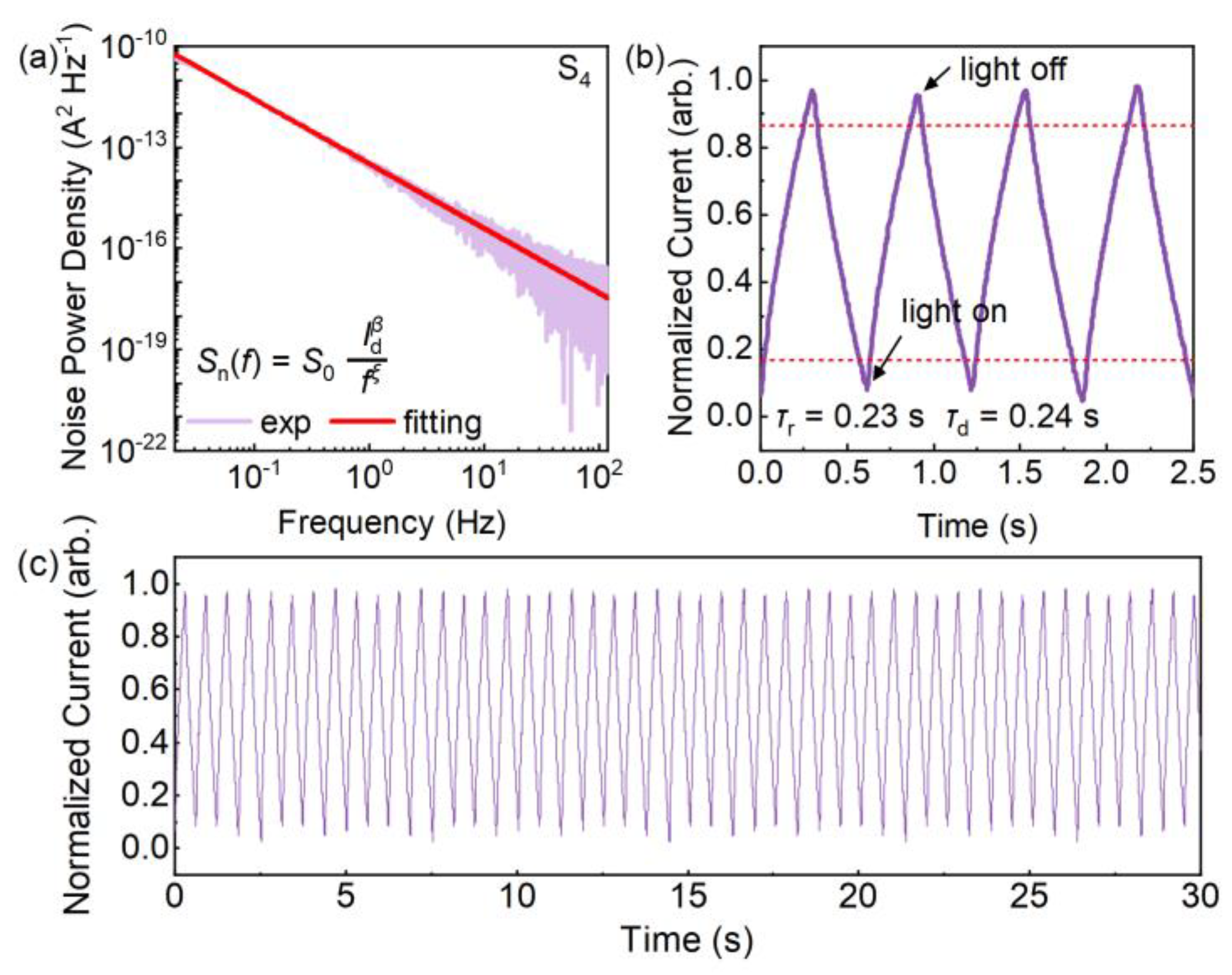
4. Conclusions
Supplementary Materials
Author Contributions
Funding
Data Availability Statement
Acknowledgments
Conflicts of Interest
References
- Lemos, S.C.S.; Romeiro, F.C.; de Paula, L.F.; Gonçalves, R.F.; de Moura, A.P.; Ferrer, M.M.; Longo, E.; Patrocinio, A.O.T.; Lima, R.C. Effect of Er3+ ions on the phase formation and properties of In2O3 nanostructures crystallized upon microwave heating. J. Solid State Chem. 2017, 249, 58–63. [Google Scholar] [CrossRef]
- Li, E.Y.; Zhou, A.F.; Feng, P.X. High-Performance Nanoplasmonic Enhanced Indium Oxide-UV Photodetectors. Crystals 2023, 13, 689. [Google Scholar] [CrossRef]
- Li, Z.Q.; Yan, T.T.; Fang, X.S. Low-dimensional wide-bandgap semiconductors for UV photodetectors. Nat. Rev. Mater. 2023, 8, 587–603. [Google Scholar] [CrossRef]
- Qi, K.; Fu, S.H.; Wang, Y.F.; Han, Y.R.; Fu, R.P.; Gao, C.; Ma, J.A.; Xu, H.Y.; Li, B.S.; Shen, A.D.; et al. High-detectivity solar-blind deep UV photodetectors based on cubic/monoclinic mixed-phase (InxGa1−x)2O3 thin films. J. Alloys Compd. 2023, 965, 171473. [Google Scholar] [CrossRef]
- Banda, R.R.; Halge, D.I.; Narwade, V.N.; Kaawash, N.M.S.; Thabit, M.Y.H.; Alegaonkar, P.S.; Bogle, K.A. Polarization-independent enhancement in UV photoconductivity of BiFeO3/Sn:In2O3 heterostructure. Phys. B 2023, 662, 414938. [Google Scholar] [CrossRef]
- Zhang, S.; Zhang, X.R.; Ren, F.; Yin, Y.; Feng, T.; Song, W.R.; Wang, G.D.; Liang, M.; Xu, J.L.; Wang, J.W.; et al. High responsivity GaN nanowire UVA photodetector synthesized by hydride vapor phase epitaxy. J. Appl. Phys. 2020, 128, 155705. [Google Scholar] [CrossRef]
- Zhang, Y.P.; Zhai, Y.N.; Zhang, H.; Wang, Z.X.; Zhang, Y.F.; Xu, R.L.; Ruan, S.P.; Zhou, J.R. A High-Performance UVA Photodetector Based on Polycrystalline Perovskite MAPbCl3/TiO2 Nanorods Heterojunctions. Sensors 2023, 23, 6726. [Google Scholar] [CrossRef] [PubMed]
- Mana-ay, H.; Chen, C.S.; Wang, X.H.; Tu, C.S.; Chen, P.Y. Polarization-sensitive UVA photodetector based on heterojunction of ITO and rare-earth doped bismuth ferrite ceramics. Ceram. Int. 2022, 48, 22083–22095. [Google Scholar] [CrossRef]
- Jheng, J.S.; Wang, C.K.; Chiou, Y.Z.; Chang, S.P.; Chang, S.J. MgZnO/SiO2/ZnO metal–semiconductor–metal dual-band UVA and UVB photodetector with different MgZnO thicknesses by RF magnetron sputter. Jpn. J. Appl. Phys. 2020, 59, SDFF04. [Google Scholar] [CrossRef]
- Wang, B.L.; Ye, L.; Yin, H.; Yu, X.X. Ferroelectrically tuned tunneling photodetector based on graphene/h-BN/In2Se3 heterojunction. Opt. Mater. 2024, 150, 115264. [Google Scholar] [CrossRef]
- Chanchal; Jindal, K.; Pandey, A.; Tomar, M.; Jha, P.K. Phase-defined growth of In2Se3 thin films using PLD technique for high performance self-powered UV photodetector. Appl. Surf. Sci. 2022, 595, 153505. [Google Scholar] [CrossRef]
- Hase, Y.; Jadhav, Y.; Aher, R.; Sharma, V.; Shah, S.; Punde, A.; Waghmare, A.; Doiphode, V.; Shinde, P.; Rahane, S.; et al. Annealing temperature effect on structural and optoelectronic properties of γ-In2Se3 thin films towards highly stable photodetector applications. J. Mol. Struct. 2022, 1265, 133336. [Google Scholar] [CrossRef]
- Li, P.P.; Wang, T.L.; Wang, A.C.; Zhao, L.; Zhu, Y.Q.; Wang, Z.W.; Gao, H.L.; Wang, W.J.; Li, K.L.; Du, C.H. Carrier-recirculating broadband photodetector with high gain based on van der Waals In2Se3/MoS2 heterostructure. Appl. Surf. Sci. 2024, 649, 159135. [Google Scholar] [CrossRef]
- Ling, C.C.; Cao, M.; Xue, X.; Zhang, T.; Feng, B.X.; Xue, Q.Z.; Wang, C.K.; Lu, H.P.; Liu, W.P. Large-Scale Synthesis of Vertically Standing In2S3 Nanosheets/Pyramidal Silicon Array Heterojunction for Broadband Photodetectors. Appl. Surf. Sci. 2023, 621, 156901. [Google Scholar] [CrossRef]
- Lu, J.T.; Yan, J.H.; Yao, J.D.; Zheng, Z.Q.; Mao, B.J.; Zhao, Y.; Li, J.B. All-Dielectric Nanostructure Fabry-Perot-Enhanced Mie Resonances Coupled with Photogain Modulation toward Ultrasensitive In2S3 Photodetector. Adv. Funct. Mater. 2021, 31, 2007987. [Google Scholar] [CrossRef]
- Lu, J.T.; Zheng, Z.Q.; Yao, J.D.; Gao, W.; Zhao, Y.; Xiao, Y.; Li, J.B. 2D In2S3 Nanoflake Coupled with Graphene toward High-Sensitivity and Fast-Response Bulk-Silicon Schottky Photodetector. Small 2019, 15, 1904912. [Google Scholar] [CrossRef] [PubMed]
- Zhang, N.N.; Cui, M.Q.; Zhou, J.X.; Shao, Z.T.; Gao, X.Y.; Liu, J.M.; Sun, R.Y.; Zhang, Y.; Li, W.H.; Li, X.H.; et al. High-Performance Self-Powered Photoelectrochemical Ultraviolet Photodetectors Based on an In2O3 Nanocube Film. ACS Appl. Mater. Interfaces 2024, 16, 19167–19174. [Google Scholar] [CrossRef] [PubMed]
- Mottram, A.D.; Lin, Y.H.; Pattanasattayavong, P.; Zhao, K.; Amassian, A.; Anthopoulos, T.D. Quasi Two-Dimensional Dye-Sensitized In2O3 Phototransistors for Ultrahigh Responsivity and Photosensitivity Photodetector Applications. ACS Appl. Mater. Interfaces 2016, 8, 4894–4902. [Google Scholar] [CrossRef] [PubMed]
- Çaldıran, Z.; Taşyürek, L.B.; Nuhoğlu, Y. The effect of different frequencies and illuminations on the electrical behavior of MoO3/Si heterojunctions. J. Mater. Sci. Mater. Electron. 2021, 32, 27950–27961. [Google Scholar] [CrossRef]
- Moudgil, A.; Sharma, K.K.; Das, S. In2O3/TiO2 Heterostructure for Highly Responsive Low-Noise Ultraviolet Photodetector. IEEE Trans. Electron. Dev. 2020, 67, 166–172. [Google Scholar] [CrossRef]
- dos Santos, R.B.; Rivelino, R.; Gueorguiev, G.K.; Kakanakova-Georgieva, A. Exploring 2D structures of indium oxide of different stoichiometry. CrystEngComm 2021, 23, 6661–6667. [Google Scholar] [CrossRef]
- Young, S.J.; Liu, Y.H.; Shiblee, M.D.N.I.; Ahmed, K.; Lai, L.T.; Nagahara, L.; Thundat, T.; Yoshida, T.; Arya, S.; Furukawa, H.; et al. Flexible Ultraviolet Photodetectors Based on One-Dimensional Gallium-Doped Zinc Oxide Nanostructures. ACS Appl. Electron. Mater. 2020, 2, 3522–3529. [Google Scholar] [CrossRef]
- Bodur, M.C.; Duman, S.; Orak, I.; Saritas, S.; Baris, O. The photovoltaic and photodiode properties of Au/Carmine/n-Si/Ag diode. Opt. Laser Technol. 2023, 162, 109251. [Google Scholar] [CrossRef]
- Xu, J.; Zheng, W.; Huang, F. Gallium oxide solar-blind ultraviolet photodetectors: A review. J. Mater. Chem. C 2019, 7, 8753–8770. [Google Scholar] [CrossRef]
- Nallabala, N.K.R.; Godavarthi, S.; Kummara, V.K.; Kesarla, M.K.; Saha, D.; Akkera, H.S.; Guntupalli, G.K.; Kumar, S.; Vattikuti, S.V.P. Structural, optical and photoresponse characteristics of metal-insulator-semiconductor (MIS) type Au/Ni/CeO2/GaN Schottky barrier ultraviolet photodetector. Mater. Sci. Semicond. Process. 2020, 117, 105190. [Google Scholar] [CrossRef]
- Asar, T.; Baran, V.; Kurtulus, G.; Dönmez, M.; Özçelik, H. Platinum doping effect on In2O3 MSM IR photodetectors. Superlattice Microst. 2018, 122, 650–660. [Google Scholar] [CrossRef]
- Jesenovec, J.; Weber, M.H.; Pansegrau, C.; McCluskey, M.D.; Lynn, K.G.; McCloy, J.S. Gallium vacancy formation in oxygen annealed β-Ga2O3. J. Appl. Phys. 2021, 129, 245701. [Google Scholar] [CrossRef]
- Chen, T.; Zhang, X.; Zhang, L.; Zeng, C.; Li, S.; Yang, A.; Hu, Y.; Li, B.; Jiang, M.; Huang, Z.; et al. High-Speed and Ultrasensitive Solar-Blind Ultraviolet Photodetectors Based on In Situ Grown β-Ga2O3 Single-Crystal Films. ACS Appl. Mater. Interfaces 2024, 16, 6068–6077. [Google Scholar] [CrossRef]
- Qian, L.X.; Liu, H.Y.; Zhang, H.F.; Wu, Z.H.; Zhang, W.L. Simultaneously improved sensitivity and response speed of β-Ga2O3 solar-blind photodetector via localized tuning of oxygen deficiency. Appl. Phys. Lett. 2019, 114, 5088665. [Google Scholar] [CrossRef]
- Ge, C.Y.; Liu, Z.Y.; Zhu, Y.C.; Zhou, Y.L.; Jiang, B.R.; Zhu, J.X.; Yang, X.K.; Zhu, Y.X.; Yan, S.Y.; Hu, H.J.; et al. Insight into the High Mobility and Stability of In2O3:H Film. Small 2024, 20, 2304721. [Google Scholar] [CrossRef]
- Qian, H.; Zhang, X.D.; Ma, Y.J.; Zhang, L.; Chen, T.W.; Wei, X.; Tang, W.B.; Zhou, X.; Feng, B.Y.; Fan, Y.M.; et al. Quasi-vertical ε-Ga2O3 solar-blind photodetectors grown on p-Si substrates with Al2O3 buffer layer by metalorganic chemical vapor deposition. Vacuum 2022, 200, 111019. [Google Scholar] [CrossRef]
- Das, S.; Paikaray, S.; Swain, I.; Senapati, S.; Naik, R. Tuning in linear and nonlinear optical parameters by interfacial mixing of Sb/Ag2Se bilayer thin films under annealing at different temperatures for optoelectronic applications. Surf. Interfaces 2023, 42, 103395. [Google Scholar] [CrossRef]
- Li, M.Q.; Yang, N.; Wang, G.G.; Zhang, H.Y.; Han, J.C. Highly preferred orientation of Ga2O3 films sputtered on SiC substrates for deep UV photodetector application. Appl. Surf. Sci. 2019, 471, 694–702. [Google Scholar] [CrossRef]
- Wu, N.; Wang, C.; Slattum, P.M.; Zhang, Y.Q.; Yang, X.M.; Zang, L. Persistent Photoconductivity in Perylene Diimide Nanofiber Materials. ACS Energy Lett. 2016, 1, 906–912. [Google Scholar] [CrossRef]
- Qian, L.X.; Wu, Z.H.; Zhang, Y.Y.; Lai, P.T.; Liu, X.Z.; Li, Y.R. Ultrahigh-Responsivity, Rapid-Recovery, Solar-Blind Photodetector Based on Highly Nonstoichiometric Amorphous Gallium Oxide. ACS Photonics 2017, 4, 2203–2211. [Google Scholar] [CrossRef]
- Greczynski, G.; Hultman, L. Reliable determination of chemical state in x-ray photoelectron spectroscopy based on sample-work-function referencing to adventitious carbon: Resolving the myth of apparent constant binding energy of the C 1s peak. Appl. Surf. Sci. 2018, 451, 99–103. [Google Scholar] [CrossRef]
- Hu, Y.; Zhang, L.; Chen, T.W.; Ma, Y.J.; Tang, W.B.; Huang, Z.J.; Li, B.T.; Xu, K.; Mudiyanselage, D.H.; Fu, H.Q.; et al. High-performance ε-Ga2O3 solar-blind ultraviolet photodetectors on Si (100) substrate with molybdenum buffer layer. Vacuum 2023, 213, 112130. [Google Scholar] [CrossRef]
- Ma, Y.J.; Feng, B.Y.; Zhang, X.D.; Chen, T.W.; Tang, W.B.; Zhang, L.; He, T.; Zhou, X.; Wei, X.; Fu, H.Q.; et al. High-performance β-Ga2O3 solar-blind ultraviolet photodetectors epitaxially grown on (110) TiO2 substrates by metalorganic chemical vapor deposition. Vacuum 2021, 191, 110402. [Google Scholar] [CrossRef]
- Wang, Y.C.; Zhu, L.; Liu, Y.; Vovk, E.I.; Lang, J.Y.; Zhou, Z.X.; Gao, P.; Li, S.G.; Yang, Y. Understanding surface structures of In2O3 catalysts during CO2 hydrogenation reaction using time-resolved IR, XPS with in situ treatment, and DFT calculations. Appl. Surf. Sci. 2023, 631, 157534. [Google Scholar] [CrossRef]
- Ma, Q.; Zheng, H.M.; Shao, Y.; Zhu, B.; Liu, W.J.; Ding, S.J.; Zhang, D.W. Atomic-Layer-Deposition of Indium Oxide Nano-films for Thin-Film Transistors. Nanoscale Res. Lett. 2018, 13, 4. [Google Scholar] [CrossRef]
- Peng, Y.H.; He, C.C.; Zhao, Y.J.; Yang, X.B. Multi-peak emission of In2O3 induced by oxygen vacancy aggregation. J. Appl. Phys. 2023, 133, 075702. [Google Scholar] [CrossRef]
- Bierwagen, O.; Speck, J.S. High electron mobility In2O3 (001) and (111) thin films with nondegenerate electron concentration. Appl. Phys. Lett. 2010, 97, 072103. [Google Scholar] [CrossRef]
- Chen, A.; Zhu, K.G.; Zhong, H.C.; Shao, Q.Y.; Ge, G.L. A new investigation of oxygen flow influence on ITO thin films by magnetron sputtering. Sol. Energy Mater. Sol. Cells 2014, 120, 157–162. [Google Scholar] [CrossRef]
- Heinemann, M.D.; Berry, J.; Teeter, G.; Unold, T.; Ginley, D. Oxygen deficiency and Sn doping of amorphous Ga2O3. Appl. Phys. Lett. 2016, 108, 022107. [Google Scholar] [CrossRef]
- Carrano, J.C.; Li, T.; Grudowski, P.A.; Eiting, C.J.; Dupuis, R.D.; Campbell, J.C. Comprehensive characterization of metal-semiconductor-metal ultraviolet photodetectors fabricated on single-crystal GaN. J. Appl. Phys. 1998, 83, 6148–6160. [Google Scholar] [CrossRef]
- Hellings, G.; John, J.; Lorenz, A.; Malinowski, P.; Mertens, R. AlGaN Schottky Diodes for Detector Applications in the UV Wavelength Range. IEEE Trans. Electron. Dev. 2009, 56, 2833–2839. [Google Scholar] [CrossRef]
- Huang, H.L.; Xie, Y.N.; Zhang, Z.F.; Zhang, F.; Xu, Q.; Wu, Z.Y. Growth and fabrication of sputtered TiO2 based ultraviolet detectors. Appl. Surf. Sci. 2014, 293, 248–254. [Google Scholar] [CrossRef]
- Abdullah, Q.N.; Yam, F.K.; Mohmood, K.H.; Hassan, Z.; Qaeed, M.A.; Bououdina, M.; Almessiere, M.A.; Al-Otaibi, A.L.; Abdulateef, S.A. Free growth of one-dimensional β-Ga2O3 nanostructures including nanowires, nanobelts and nanosheets using a thermal evaporation method. Ceram. Int. 2016, 42, 13343–13349. [Google Scholar] [CrossRef]
- Nikitskiy, I.; Goossens, S.; Kufer, D.; Lasanta, T.; Navickaite, G.; Koppens, F.H.L.; Konstantatos, G. Integrating an electrically active colloidal quantum dot photodiode with a graphene phototransistor. Nat. Commun. 2016, 7, 11954. [Google Scholar] [CrossRef]
- Abbas, S.; Ban, D.K.; Kim, J. Functional interlayer of In2O3 for transparent SnO2/SnS2 heterojunction photodetector. Sens. Actuators A-Phys. 2019, 293, 215–221. [Google Scholar] [CrossRef]
- Fang, Y.J.; Huang, J.S. Resolving Weak Light of Sub-picowatt per Square Centimeter by Hybrid Perovskite Photodetectors Enabled by Noise Reduction. Adv. Mater. 2015, 27, 2804. [Google Scholar] [CrossRef] [PubMed]
- Chen, Q.; Yang, J.W.; Osinsky, A.; Gangopadhyay, S.; Lim, B.; Anwar, M.Z.; Khan, M.A.; Kuksenkov, D.; Temkin, H. Schottky barrier detectors on GaN for visible-blind ultraviolet detection. Appl. Phys. Lett. 1997, 70, 2277–2279. [Google Scholar] [CrossRef]
- Pooja, P.; Chinnamuthu, P. Annealed n-TiO2/In2O3 nanowire metal-insulator-semiconductor for highly photosensitive low-noise ultraviolet photodetector. J. Alloys Compd. 2021, 854, 157229. [Google Scholar] [CrossRef]
- Zhang, M.X.; Yu, H.; Li, H.; Jiang, Y.; Qu, L.H.; Wang, Y.X.; Gao, F.; Feng, W. Ultrathin In2O3 Nanosheets toward High Responsivity and Rejection Ratio Visible-Blind UV Photodetection. Small 2023, 19, 2205623. [Google Scholar] [CrossRef] [PubMed]
- Cui, M.Q.; Shao, Z.T.; Qu, L.H.; Liu, X.; Yu, H.; Wang, Y.X.; Zhang, Y.X.; Fu, Z.D.; Huang, Y.W.; Feng, W. MOF-Derived In2O3 Microrods for High-Performance Photoelectrochemical Ultraviolet Photodetectors. ACS Appl. Mater. Interfaces 2022, 14, 39046–39052. [Google Scholar] [CrossRef] [PubMed]
- Sharmila, B.; Dwivedi, P. In2O3 decorated TiO2 for broadband photosensing applications. Semicond. Sci. Technol. 2023, 38, 115009. [Google Scholar]
- Veeralingam, S.; Badhulika, S. Enhanced carrier separation assisted high-performance piezo-phototronic self-powered photodetector based on core-shell ZnSnO3@In2O3 heterojunction. Nano Energy 2022, 98, 107354. [Google Scholar] [CrossRef]
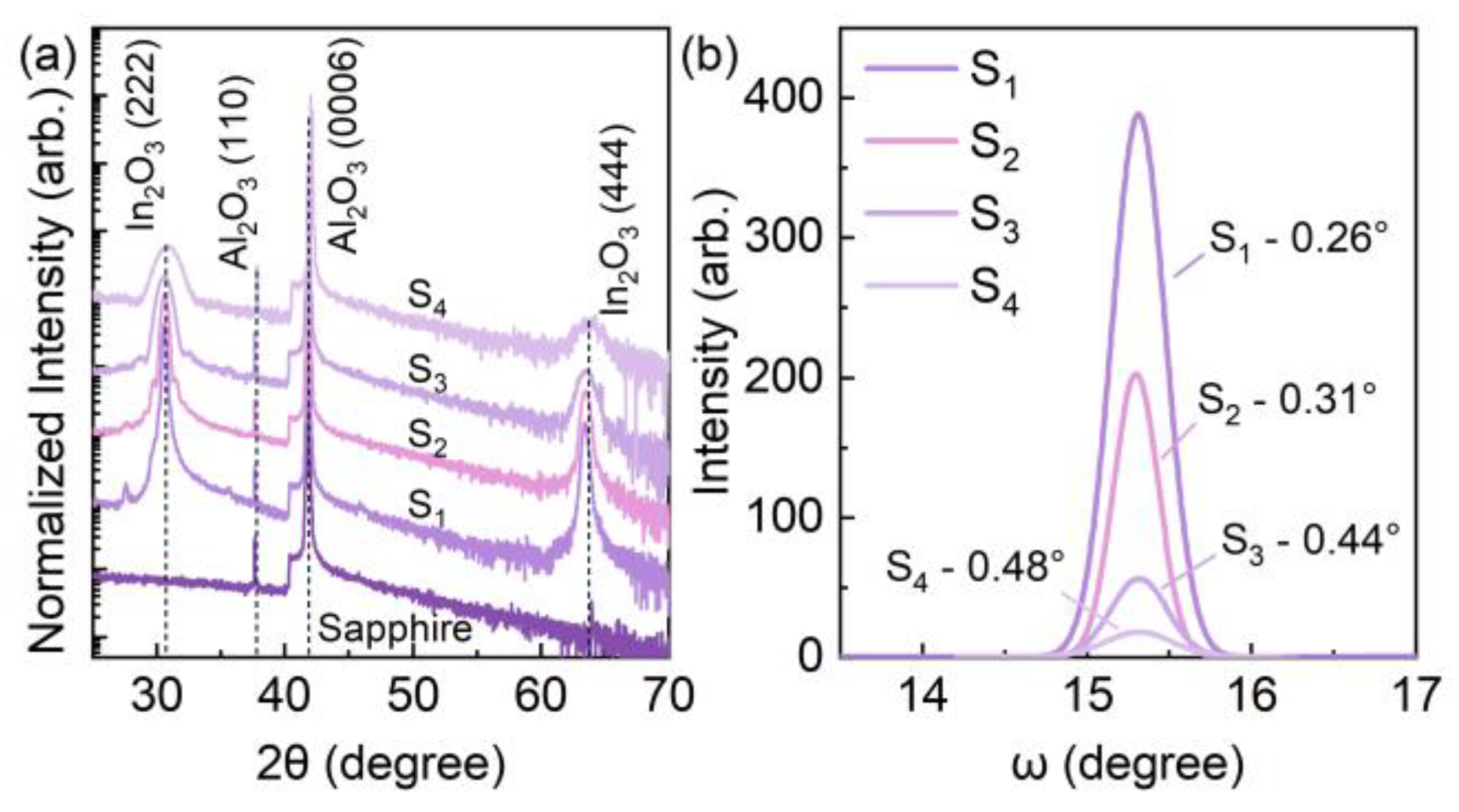


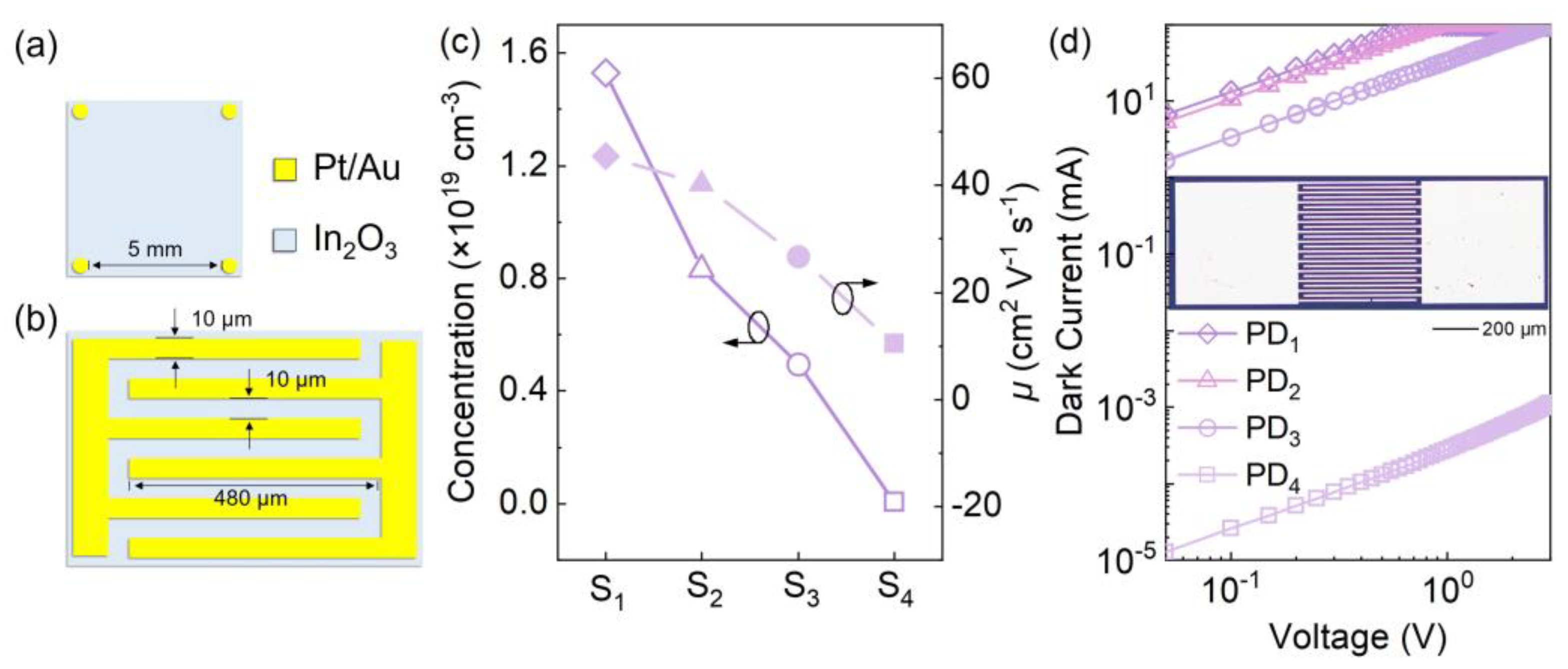
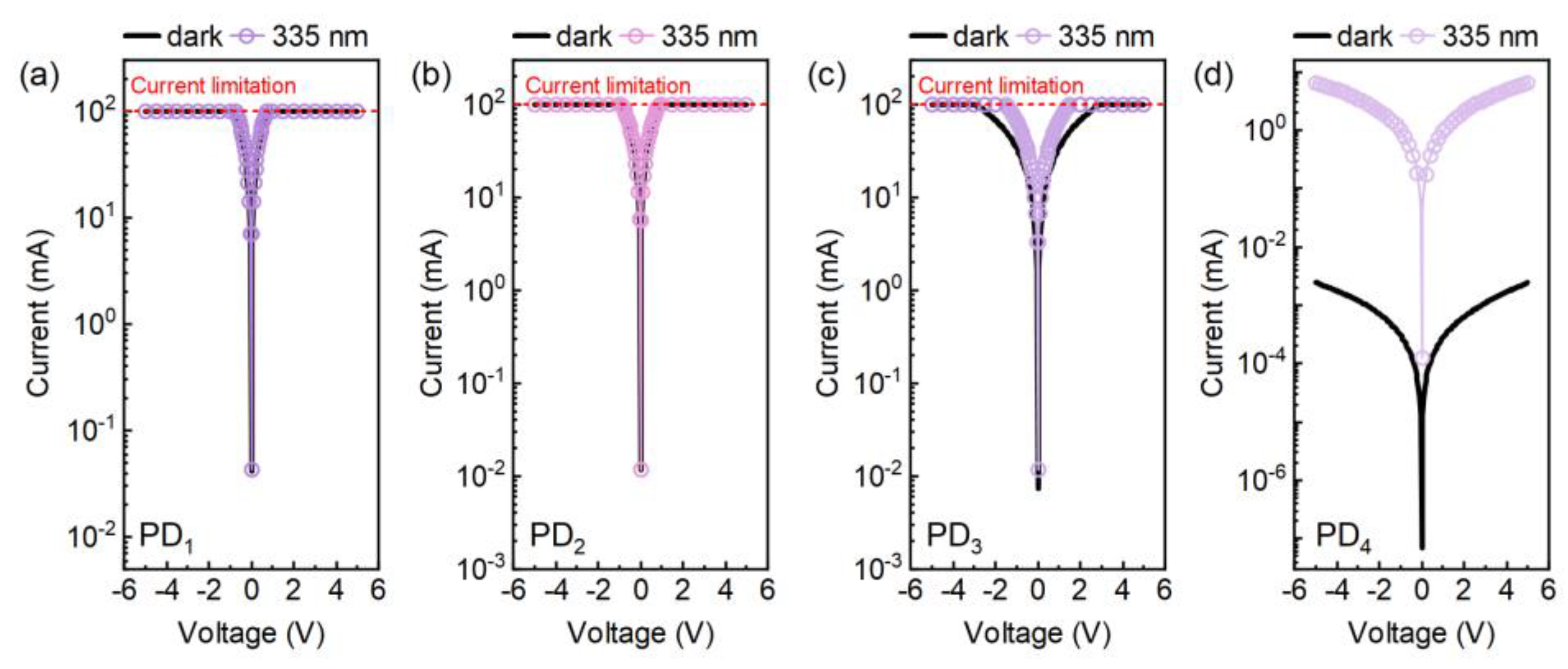
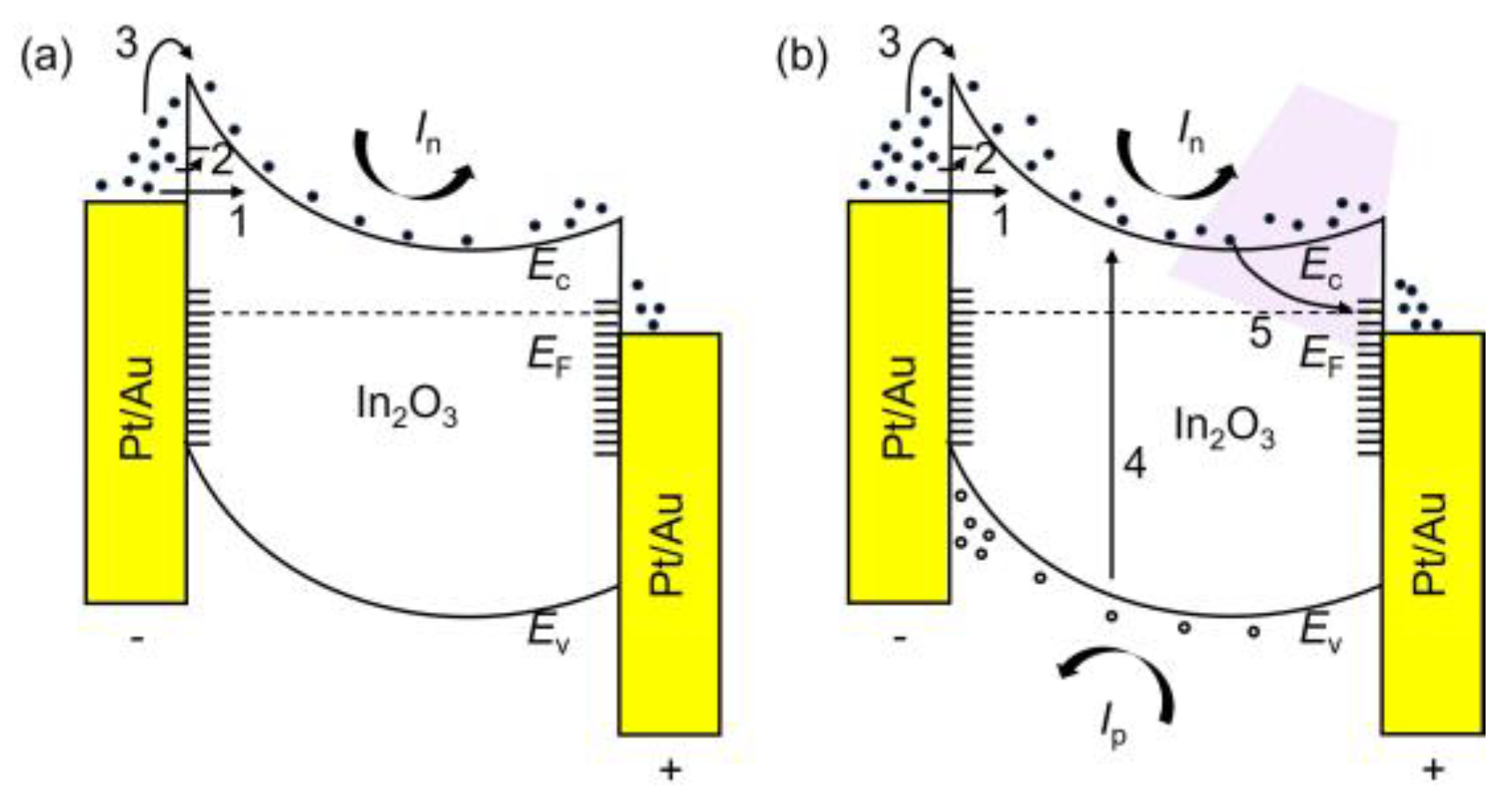
Disclaimer/Publisher’s Note: The statements, opinions and data contained in all publications are solely those of the individual author(s) and contributor(s) and not of MDPI and/or the editor(s). MDPI and/or the editor(s) disclaim responsibility for any injury to people or property resulting from any ideas, methods, instructions or products referred to in the content. |
© 2024 by the authors. Licensee MDPI, Basel, Switzerland. This article is an open access article distributed under the terms and conditions of the Creative Commons Attribution (CC BY) license (https://creativecommons.org/licenses/by/4.0/).
Share and Cite
Li, Y.; Chen, T.; Ma, Y.; Hu, Y.; Zhang, L.; Zhang, X.; Yang, J.; Wang, L.; Zhang, H.; Yan, C.; et al. Ultrahigh Responsivity In2O3 UVA Photodetector through Modulation of Trimethylindium Flow Rate. Crystals 2024, 14, 494. https://doi.org/10.3390/cryst14060494
Li Y, Chen T, Ma Y, Hu Y, Zhang L, Zhang X, Yang J, Wang L, Zhang H, Yan C, et al. Ultrahigh Responsivity In2O3 UVA Photodetector through Modulation of Trimethylindium Flow Rate. Crystals. 2024; 14(6):494. https://doi.org/10.3390/cryst14060494
Chicago/Turabian StyleLi, Yifei, Tiwei Chen, Yongjian Ma, Yu Hu, Li Zhang, Xiaodong Zhang, Jinghang Yang, Lu Wang, Huanyu Zhang, Changling Yan, and et al. 2024. "Ultrahigh Responsivity In2O3 UVA Photodetector through Modulation of Trimethylindium Flow Rate" Crystals 14, no. 6: 494. https://doi.org/10.3390/cryst14060494





